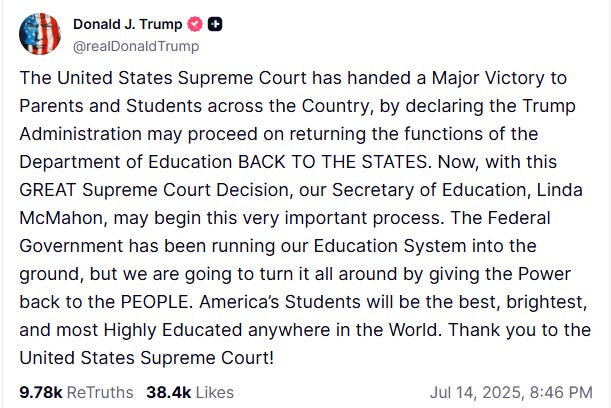SCOTUS allows mass layoffs at Department of Education to go forward
but what happens to all Americans being able to access equal educational opportunities?
The Supreme Court hears roughly 80 cases per year. In addition to those merit-based cases in which both parties must file written briefs and the court issues a majority opinion following deliberations, the Supreme Court also hears emergency cases, also known as shadow docket cases, to answer legal issues requiring a more immediate ruling. Unlike typical Supreme Court cases, shadow docket cases determine whether a policy can move forward, not whether the policy itself is legal. In these specific emergency cases, the Supreme Court is not ruling on the law itself so there is no majority opinion issued to explain how the court came to its decision; lower courts will ultimately be able to rule on the policy’s legality in future cases.
Shadow docket cases are intended to be rare. Only a handful were presented during each of George W. Bush’s and Barack Obama’s tenures in office (both presidents served 2 full terms). In Trump’s first six months in office in his second term, his administration has already made 20 emergency appeals to the Supreme Court. In the Supreme Court’s most recent shadow docket ruling, the court is permitting the Trump administration to move forward with gutting the Department of Education.
Though the Supreme Court majority is not required to (and did not) submit an opinion as to why they ruled as they did in this case, the minority did issue an opinion penned by Justice Sotomayor:
The majority is either willfully blind to the implications of its ruling or naive, but either way the threat to our Constitution’s separation of powers is grave..
Neither the President nor Secretary [of Education] McMahon made any secret of their intent to ignore their constitutional duties. President Trump repeatedly called for the immediate abolition of the Department both during his campaign and after taking office.
Joined by two other Supreme Court justices, Sotomayor in her dissent is clearly troubled by her other colleagues permitting the Trump administration to gut an agency when that decision should be determined by the legislative branch, Congress. A growing concern in Trump 2.0 is the absence of any meaningful checks on executive power. And now that alarm will force a nation to more deeply appreciate the state of education in America.
Within 2 hours of the Supreme Court ruling, the Department of Education notified staff of its intent to press forward and markedly downsize by August 1st (approximately 2 weeks from today). Presumably the Department of Education will follow its March 2025 plan to reduce the department by half, comprised of 600 employees who already accepted the federal government’s voluntary resignation opportunity and more than 1300 staff to be officially laid off. Part of the duties of those cut by the department include protecting “students and teachers from discrimination, assisting college financial aid offices and compiling data about the nation's schools.”
In the Department’s note to staff:
The Department appreciates your service and recognizes the difficulty of the moment. This RIF [reduction in force] action is not a reflection upon your performance or conduct and is solely due to agency restructuring, as described in previous correspondence.
To help illustrate the known impact, schools K-12 will lose roughly 10% of their funding, as that currently comes from the federal government. Universities this year will continue to have extensive issues with financial aid administration as that particular federal office had the highest number of employees cut. And ironically for an administration so focused on revenue generation, student loan borrowers may receive significantly less payment reminders as federal student loan servicers will not be returning to work. In President Trump’s Executive Order, the administration admits the federal student loan portfolio of more than $1.6 trillion is roughly the size of Wells Fargo’s loan portfolio; but since that bank has more than 200,000 employees, the Trump administration thinks a federal staff of less than 1,500 cannot possibly do the job (so now the Treasury Department may do it, which itself lost 11,000 employees in March but currently has over 100,000 employees for all Treasury functions including tax collection via the IRS).
These drastic federal cuts follow the Trump’s administration threatening to cut Ivy League universities’ federal funding for supposed antisemitism and detaining/deporting students who protested the war in Gaza. In March, the Department of Education reported five dozen universities were under investigation for antisemitism, and just yesterday officials from three non ivy universities testified before Congress regarding antisemitism on their campuses.
Faculty and staff at those universities (Georgetown University, CUNY and UC Berkeley) wrote in response to the most recent of nine Congressional hearings on antisemitism at college campuses:
Despite their stated purpose, these congressional hearings are not about actually addressing antisemitism in higher education. Rather, their agenda is to bring the higher education sector to heel. The hearings are part of longstanding and ongoing efforts to attack academic freedom, faculty governance and higher education as a public good.
Though there is sufficient merit to believing advocating for the Palestinian people and their rights is the primary reason for these Congressional hearings, it cannot be ignored that any university found not in federal compliance could potentially lose federal funding. And if that were not enough, the Trump administration intends to cut federal funding to tribal colleges and universities by almost 90%, which would obviously devastate higher education for Indigenous communities.
After the Supreme Court ruling, 24 states and the District of Colombia sued the Trump administration to unfreeze more than $6 billion in federal funding. Arizona, a plaintiff in this case, has a school district in which classes resumed today. For schools across the nation, the rapidity of funds being frozen will make it extremely difficult for administrators to adjust their budgets and resourcing in time for the upcoming school year.
Even senior Republican lawmakers are upset. Senator Susan Collins (R - ME), chair of the House appropriations committee, told Education Week:
I strongly oppose the administration's decision to pause the delivery of education formula grant funding to states and local school districts across the country ... The administration should release these funds without any further delay.
Representative Tim Walberg (R-MI), chair of the House education committee, said:
It is my understanding that the administration is working to ensure these funds are being used to support students and make sure the civil rights of students and educators are not being violated within these programs. However, these funds were appropriated by Congress, and it is important that all funds Congress appropriated be promptly distributed.
Echoes of Justice Sotomayor’s grave concern can be heard in Republican Representative’s Walberg’s comments. In the minority’s dissent, Sotomayor wrote the majority’s decision “will unleash untold harm, delaying or denying educational opportunities and leaving students to suffer from discrimination, sexual assault, and other civil rights violations without the federal resources Congress intended.”
Of course the potential damage to students and teachers is unknown as the Constitutional crisis plays out. Major Department of Education functions could be potentially outsourced to other government departments - civil rights issues to the Justice Department, student disability rights handled by Health and Human Services and student loans managed by the Treasury Department.
However, what department or individual will ensure equity of education, which was the intent of the Department of Education following intense civil rights and anti-poverty movements in the United States? Do we know if the Trump administration honestly believes equal access to education is considered accomplished or no longer a concern. Both? Neither?


